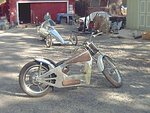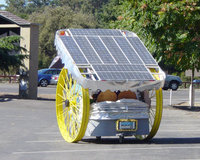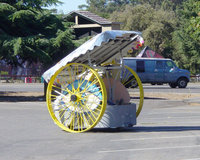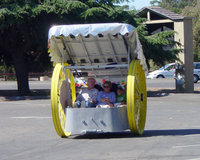Electric vehicle conversion
An electric vehicle conversion is the modification of a conventional internal combustion engine (ICE) driven vehicle to battery electric propulsion, creating a battery electric vehicle. In some cases the vehicle may be built by the converter, or assembled from a kit car, and vehicles of this type are also noted below.
Vehicles may be converted by a manufacturer (as was done by Ford Motor Company to create the Ford Ranger EV) or by an independent converter that purchases new vehicles without a motor or related equipment (these vehicles are called "gliders" to offer a two-stage vehicle and the procedure is called third-party (power)trainization). A two-stage vehicle is a vehicle that has been built by two separate manufacturers. The result is a standard, complete vehicle.
Most conversions in North America are performed by hobbyists who typically will convert a well used vehicle with a non-functioning engine, since such defective vehicles can be quite inexpensive to purchase. Other hobbyists with larger budgets may prefer to convert a later model vehicle, or a vehicle of a particular type.
In some countries, the user can choose to buy a converted vehicle of any model in the automaker dealerships only paying the cost of the batteries and motor, with no installation costs (it is called preconversion or previous conversion).
Elements of a conversion
- The battery pack, which provides a source of electrical power.
- The charger which restores energy to the batteries (which may be mounted within the vehicle or at a special charging station at some fixed location)
- The power controller, which regulates the flow of energy between the battery and the motor(s)
- One or more electric motors and their mechanical attachment to the driveline
- Power conductors connecting the battery, controller, and motor(s)
- Accessory equipment to power auxiliary equipment such as power brakes and heating system
- Control circuitry and equipment to allow control and interlocking of the various components
- Instrumentation specific to the operation and maintenance of the conversion
Vehicle types (including scratch built)
Electric bicycle
An electric bicycle is a class of bicycles that are fitted with an electric motor. Often they are powered by rechargeable batteries however some experimental electric bicycles run directly on or recharge their batteries via solar panels, fuel cells, gas generators or other alternative energy sources. Some experimenters have even used super capacitors to store energy. Using an on-board generator may impact the legal jurisdictional definition of an electric bicycle. A few types of electric bicycles are able to re-capture energy from braking and can re-charge the batteries while braking or travelling down hills (regenerative braking). With the advent of newer technology further features can be expected.
Some electric bikes have features where the motor can move the bicycle by itself if the rider chooses not to pedal, while others require the rider to pedal at all times. This latter type may in some jurisdictions allow the vehicle to be used on bicycle trails that otherwise prohibit motorized vehicles of any kind. (See motorized bicycle).
The conversion of a bicycle to electric power is probably the lowest cost means of learning conversion methods. Battery packs are usually lead acid gel cells since these are available in small sizes suitable for this application. It is also practical to experiment with more expensive battery types since only a small pack is required. It is possible to repurpose battery packs and chargers intended for powering toys and similar small electrical devices.
Electric motorcycle and Scooters
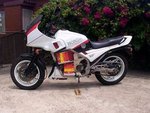 Converted Electric Motorcycle [http://www.austinev.org/evalbum/457 1984 VF750 Honda "ZEVY" |
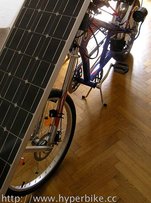 Solar cruiser hyperbike.cc |
Low speed Scooters are not typically suitable for on the road use. These may be configured for either standing or sitting use. Some local laws apply bicycle laws to such scooters such as helmet and pedestrian right of way considerations.
Motorcycle conversions are a specialty niche which can offer an opportunity to build a relatively low cost electric vehicle. Most of these use a two wheel configuration, although the two types of three wheel vehicle (and sometimes four wheel vehicles) are classified as motorcycles in many jurisdictions if their weight is sufficiently low (typically around 1000 pounds maximum). If a tricycle layout is employed, greater handling stability is obtained with the single wheel at the back, with normal automotive type front wheel steering, as compared with placing the single wheel in the front.
Economy coupe
Owing to its light weight and efficiency, a light vehicle can make an excellent choice- particularly if care is taken in component selection and placement. It is possible to obtain conversion kits for some popular light vehicles, most notably the rear motor, rear drive Volkswagen Beetle, its Type 3 evolution, and its successor, the front motor/drive VW Rabbit.
By converting a light vehicle it is possible to use a smaller motor, which both weighs and costs less than a larger motor. A lighter overall vehicle weight will reduce power consumption in start and stop traffic and so increase range in many practical driving conditions.
(At least one commercial converter, Solectria, has converted the front wheel drive General Motors Geo Metro for electric use, creating the Solectria Force.)
Canadian Electric Vehicles have conversion kits for an electric Geo and a whole range of vehicles from compacts to trucks.
Compact sedan or coupe
A compact sedan may be a better choice than a subcompact owing to better load capacity and more room for battery placement. Some commercial EV Conversions use vehicles in this size range. One example is a 1992 Honda Civic [1]. In this conversion, the back seat was retained, and there is still enough room to sink nine flooded lead acid batteries low in the trunk where the spare tire was located, as well as another nine batteries under the hood. With suspension modifications, (increasing shock length & spring rating), the car must still be below GVWR , even with the driver and passengers. Exceeding the total design weight of the vehicle would be illegal and foolhardy.
Full size sedan
Full size sedans and minivans are generally considered to be poor candidates for EV conversion. As the suspensions and tires are already operating close to the maximum permissible it may be necessary to make substantial modifications in these areas. It may be easier to obtain upgraded suspension components for some smaller vehicles, if these are also typically used for sports racing (particularly autocross). Starting with a heavy vehicle and adding batteries will result in poor performance in acceleration, handling, braking, and economy of operation.
Sports car
For a person interested in sports car performance and appearance, the creation of a satisfying conversion will likely lead to a number of difficulties in such details as battery disposition, as such vehicles generally have available space distributed in small volumes around the vehicle. This leads to complexity in securing and wiring batteries. Such vehicles can offer stunning performance in the lower speed ranges owing to light weight and rear wheel drive and may also offer good range from their superior aerodynamics.
Tesla Motors has produced a spectacular high end electric sports car, although not a conversion but rather being of new construction following an electrically powered initial design.
Sterling Sports Cars LLC Low cost sports car conversion option. If appearance is as important as performance this company offers DIY options and turnkey cars. Very aerodynamic and space for battery options. Retro European styling from the 70's with modern details.
The Bradley GT II as well as other VW based kit cars are very popular conversion candidates due to their being inexpensive, extensive support groups as well as their simple sports car design. Availability of conversion kits for these cars are quite prevalent with commercial retail establishments that specialize in EV conversions.
Light truck
Light trucks are especially suitable for hobbyist conversion because it is easy to locate batteries remote from the passenger compartment and there is a good load handling capacity for the use of heavy batteries such as the flooded lead-acid batteries commonly used in golf carts. Light trucks also offer substantial utility in use simply because they are trucks. Even if a portion of the weight capacity is removed by the presence of batteries within the cargo bed, much of the spacial utility remains. A light truck is highly recommended as a first conversion effort because of the simplicity of component layout.
Canadian Electric Vehicles produce conversions for many types of vehicles - including light trucks.
Other trucks - full size and most SUVs
These are rarely converted due to their excessive weight, instability, and aerodynamic inefficiencies. To make the situation worse, many modern trucks/SUVs continue to get bulkier and heavier while their frames (or unibodies) are built thinner and lighter. As a direct result, the payload carrying capacity and thus the GVWR of the vehicles goes down. Such a trait is not desirable because it limits the weight of the battery pack that can be carried, limiting the maximum battery-to-vehicle weight ratio that could be achieved for the vehicle when converted to an EV. (Such considerations are important due to current price, weight, and performance limitations current battery technoligies.) For a given battery type, reducing the battery-to-vehicle weight ratio always results in reduced vehicle range per charge. However, despite these mostly unavoidable limitations, several SUVs and larger trucks have been successfully converted to electric power by hobbyists. Some examples include the "Gone Postal" van converted to an EV racer by Roderick Wilde and Suckamps EV Racing, the 1971 Land Rover EV converted by Wilde Evolutions, and the 1988 Jeep Cherokee EV converted by Nick Viera.
Electric buses
The principle efforts in the development electric buses without trolleys and wires have involved limited production of very expensive fuel cell vehicles. Most economically effective development in this area involves the creation of hybrid buses, well suited to this application owning to frequent stops and starts and effective energy recovery and release in this cycle. Another solution is the use of battery electric buses that follow the principle of replacing (discharged batteries) instead of recharging.
Racers
Hotrod
While this type of vehicle is usually made to be a "street legal" performance machine, it may also be developed for occasional use as a drag racing vehicle. The leading vehicle in this field is the "Maniac Mazda" [2] a Mazda RX-7 sports car converted from rotary engine to electric by Roderick Wilde. This vehicle can outrun Dodge Viper and Ferrari sports cars in quarter mile drag races.
Autocross racer
EVs may prove to be especially suitable for autocross contests as low speed acceleration is especially important to success in this type of racing. Specific classes for electric autocross (called electrocross ) are being introduced in some venues. Vehicles for these will typically be economy car conversions or custom built chassis but with excess rear weight bias to allow agile handling under the control of an experienced driver (such rearward balance may be dangerous for everyday use).
Drag racer
Intended only for specialized straight line quarter mile (acceleration) racing this type of vehicle is used only "off road" at specialized "drag strips".
High speed straight line racer

Even more specialized than the drag racer this is intended to obtain high speeds on long, straight, and flat raceways, such as the dry lake beds found in locations such as the Bonneville Salt Flats.
Custom chassis
Suitable for a builder who is capable of constructing a kit car, with good abilities and equipment in machining and welding this can result in a unique vehicle. It is especially suitable for the construction of a lightweight vehicle that can offer exceptional performance.
Novelty solar vehicle
Above: Bob Schneeveis[3][4][5] demonstrates his Silver Sofa to the delight of his passengers. This can spin rapidly in place as does a carnival ride and its batteries are recharged by the solar panels.
A novelty vehicle or an electric powered art car may not be suitable for on road use. Applications include electric vehicle show demonstrations, parades, parade floats, float towing, and eclectic off-road gatherings such as Burning Man. This vehicle is ideal for the beach and to promote tourist places.
See also
External links
- The DIY Electric Car Discussion Forum - The main EV Conversion web community
- The EV Photo Album - Contains photos and information of many types/styles of EVs and EV Conversions
- The Electric Vehicle Discussion List (EVDL) - A helpful resource for all current and future EV owners, converters, and enthusiasts
- An electric motorcycle builder shows construction details

